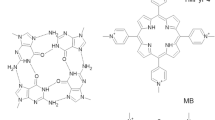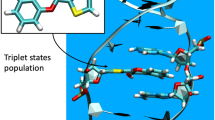Abstract
The photophysical properties of the polyamide PyPyPyβDp (PPP) were investigated by means of steady-state absorption and fluorescence spectroscopies, as well as time-resolved fluorescence spectroscopy. It was found that the excited-state properties of PPP are very sensitive to solvents. In TKMC buffer PPP exhibited weak fluorescence with a decay time constant of 16 ps, while with the decrease of the solvent polarity PPP showed the blue-shifted peak position, increased intensity and lengthened life-time for its fluorescence behavior. In the presence of calf thymus DNA, it was observed that the fluorescence intensity was enhanced and the fluorescence lifetime increased from 16 to 32 ps for PPP, which verified that PPP bound into the minor groove of DNA duplex.
Similar content being viewed by others
References
Dervan, P. B., Molecular recognition of DNA by small molecules, Bioorganic & Medicinal Chemistry, 2001, 9: 2215–2235.
Rucker, V. C., Foister, S., Melander, C., Dervan, P. B., Sequence specific fluorescence detection of double strand, J. Am. Chem. Soc., 2003, 125(5): 1195–1202.
Zimmer, C., Wahnert, U., Nonintercalating DNA-binding ligands: Specificity of the interaction and their use as tools in biophysical, biochemical and biological investigation of the genetic material, Prog. Biophys. Mol. Biol., 1986, 47: 31–112.
Chiang, S. Y., Welch, J., Rauscher, F. J., Beerman, T. A., Effects of minor groove binding drugs on the interaction of TATA box binding protein and TFA with DNA., Biochemistry, 1994, 33: 7033–7040.
Kopka, M. L., Yoon, C., Goodsell, D., Pjura, P., Dickerson, R. E., The molecular origin of DNA-drug specificity in netropsin and distamycin, PNAS, 1985, 82: 1376–1380.
Pelton, J. K., Wemmer, D. E. Structural characterization of a 2:1 distamycin A/d(CGCAAATTGGC) complex by two-dimensional NMR, PNAS, 1989, 86: 5723–5727.
Lown, J. W., Krowicki, K., Bhat, U. G., Skorobogaty, A., Ward, B., Dabrowiak, J. C., Molecular recognition between oligopep-tides and nucleic acids: Novel imidazole-containing oligopeptides related to netropsin that exhibit altered DNA sequence specificity, Biochemistry, 1986, 25: 7408–7416.
Mrksich, M., Wade, M. S., Dwyer, T. J., Geierstanger, B. H., Wemmer, D. E., Dervan, P. B., Antiparallel side-by-side dimeric motif for sequence-specific recognition in the minor groove of DNA by the designed peptide 1-Methylimidazole-2-carboxamide netropsin, PNAS, 1992, 89: 7586–7590.
Wade, M. S., Mrksich, M., Dervan, P. B., Binding affinities of synthetic peptides, pyridine-2-carboxamidonetropsin and 1-methylimidazole-2-carboxamidonetropsin, that form 2:1 complexes in the minor groove of double-helical DNA, Biochemistry, 1993, 32: 11385–11389.
Dervan, P. B., Burli, R. W., Sequence-specific DNA recognition by polyamides, Curr. Opin. Chem. Biol., 1999, 3: 688–693.
Stockert, J. C., Castillo, P. D., Bella, J. L., DNA-induced distamycin A fluorescence, Histochemistry, 1990, 94: 45–47.
Baliga, R., Crothers, D. M. et al., Kinetic consequences of covalent linkage of DNA binding polyamides, Biochemistry, 2001, 40: 3–8.
Baliga, R., Crothers, D. M., On the kinetics of distamycin binding to its target sites on duplex DNA, PNAS, 2000, 97: 7815–7818.
Baliga, R., Crothers, D. M., The kinetic basis for sequence discrimination by distamycin A, J. Am. Chem. Soc., 2000, 122: 11751–11752.
Zhang, H., Wang, P., Wang, X., Feng, J., Xu, S., Ai, X., Zhang, X., Zhang, J., Mechanism of intramolecular charge transfer in DNA helix as probed by the use of the fluorescent 2-aminopurine, Science in China, Ser. B, 2004, 47(5): 367–372.
Tang, F., Wang, J., Liu, D., Li, J., Yuan, G., Systematical synthesis of distamycin analogues and their interaction with herring sperm DNA, J. Chin. Chem. Soc-Taip, 2002, 49: 1073–1077.
Chen, G. Z., Huang, Z. X., Xu, J. G. et al., The Fluorescence Analysis Method (in Chinese), Beijing: Science Press, 1990.
Author information
Authors and Affiliations
Corresponding authors
Rights and permissions
About this article
Cite this article
Zhang, H., Wang, J., Wu, Y. et al. Fluorescence dynamics of interactions between polyamide PyPyPyβDp and DNA. SCI CHINA SER B 49, 75–80 (2006). https://doi.org/10.1007/s11426-005-0025-6
Received:
Accepted:
Issue Date:
DOI: https://doi.org/10.1007/s11426-005-0025-6




